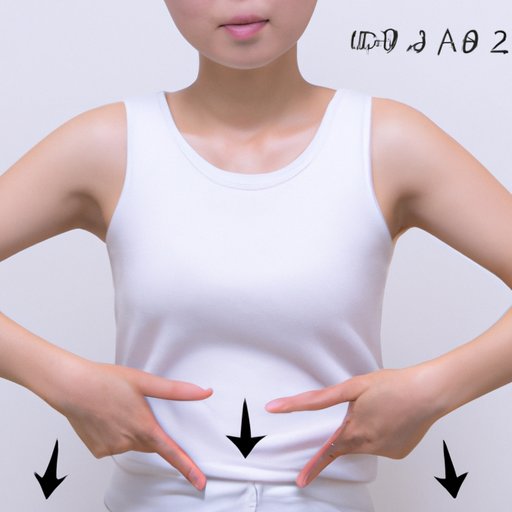
Introduction
Stretch marks are a common occurrence, affecting approximately 80% of people at some point in their lives. Though they are not harmful, these scars can be unsightly and may cause emotional distress for some individuals. Many people believe that losing weight will undoubtedly lead to an increase in the appearance of stretch marks.
This article aims to uncover the truth behind the myth. We will take a closer look at what causes stretch marks, how weight loss might play a role in their appearance, and treatment and avoidance options. Additionally, we’ll explore the emotional toll stretch marks can have and provide tips on coping with them to promote a healthy body image.
Myth Busted: Do You Really Get Stretch Marks When You Lose Weight?
The short answer is that no, not everyone who loses weight will get stretch marks.
Stretch marks are scars that form when collagen fibers in the skin tear due to rapid stretching of the skin, causing the underlying blood vessels to show through. This is usually a result of growth spurts, pregnancy, or sudden weight gain.
It is a common belief that weight loss will automatically result in the formation of stretch marks since you are reducing skin volume. But the reality is that weight loss itself is not a direct cause of stretch marks.
Weight Loss and Stretch Marks: What You Need to Know
While weight loss does not cause stretch marks, it can contribute to their formation. When you lose weight, your skin becomes lax and loose, which can cause stretch marks to be more apparent if already present.
Age, genetics, and ethnicity also play a role in the development of stretch marks. Younger people who experience rapid increases in height or muscle mass tend to have more stretch marks than older individuals.
Stretch marks are most common in those with darker skin tones, but they can affect anyone.
Factors that Influence the Appearance of Stretch Marks During Weight Loss
When trying to lose weight, it’s essential to maintain a healthy balance in your diet and exercise regimen. Rapid weight loss can cause your skin to stretch and sag, increasing the likelihood of stretch marks.
However, your skin’s elasticity is also an important factor when it comes to stretch marks. Younger skin has more elasticity, while older skin typically becomes less supple and more susceptible to stretch marks.
You can help maintain your skin’s elasticity by staying hydrated, eating foods rich in vitamins that promote healthy skin, and engaging in regular exercise. Resistance training can help build muscle and improve skin tone, too.
Explanation of the Anatomy of Stretch Marks
Stretch marks occur in the middle layer of the skin, or dermis. When collagen fibers and elastin fibers are stretched too far, they break and are replaced by scar tissue. This damage causes the marks we see on the skin’s surface, which is visible as pink, reddish or purplish grooves that can lighten over time to become silvery-white in color.
Stretch marks can appear anywhere on the body where there is rapid growth. The most common areas are the abdomen, hips, thighs, buttocks, breasts, and upper arms.
Discussion of the Different Types of Stretch Marks
Aside from the color variation, stretch marks are also categorized based on their appearance.
Striae rubra is a newly formed stretch mark that appears pink or red in color. They may feel itchy or sore and are typically more susceptible to treatment.
Striae alba is an older stretch mark that appears white or silver in color, often indented into the skin. Their occurrence is harder to reverse through treatment than fresh, red ones.
How to Prevent or Reduce Stretch Marks When Losing Weight
Although not entirely preventable, there are steps you can take to lessen the impact of stretch marks when losing weight.
1. Stay hydrated: Drinking plenty of water keeps skin hydrated and helps maintain its elasticity.
2. Moisturize: Applying moisturizer to skin regularly can help prevent dryness and itching, minimizing the chances of stretch marks occurring. Use products that contain vitamin E, collagen, or cocoa butter.
3. Manage your weight loss: Extreme weight loss can lead to damage to the skin’s elastic fibers. Manage your weight loss and pay attention to losing weight healthily. A safe rate of weight loss is between half a kilo to 1 kilo per week.
5. Build muscle: Strength training builds muscle, which can help firm the skin and reduce the appearance of stretch marks.
6. Laser therapy: Though not a cheap option, laser therapy can help reduce the appearance of stretch marks by improving the skin’s texture.

Treatment Options for Reducing the Appearance of Stretch Marks
As mentioned, stretch marks can be stubborn and challenging to treat. However, there are some treatment options available that can help reduce their appearance.
1. Topical treatments: Over the counter skin creams and ointments can help to hydrate the skin and reduce inflammation. You can opt for products that contain glycolic acid, hyaluronic acid, and vitamin C.
2. Prescription-based treatments: Certain types of prescription creams and ointments help to fade stretch marks and hinder the development of new ones.
3. Microdermabrasion: This treatment uses a wand that emits tiny particles to exfoliate the top layer of skin and improve collagen production.
4. Chemical peels: Acids like glycolic and trichloroacetic acid can be used in a controlled manner to reduce the appearance of stretch marks.
5. Laser therapy: Laser treatments work by creating small wounds that stimulate the healing process and the production of collagen.
Weight Loss Success Stories:
People who avoid Stretch Marks
Many individuals have lost weight without developing stretch marks. While there is no one way to prevent stretch marks, focusing on overall health is crucial.
Here are some personal stories of successful weight loss journeys without stretch marks:
1. Amber, age 32, lost 40 kilos by following a healthy diet and engaging in exercise. She kept the weight off and stayed hydrated and moistureated to keep her skin healthy throughout her weight loss journey.
2. Mike, age 45, lost over 50 kilos by gradually increasing his activity levels and adopting a balanced diet. He also stayed hydrated and incorporated weight training to help maintain skin tone.
From Stretch Marks to Confidence: Tips on Dealing with Stretch Marks Caused by Weight Loss
Stretch marks may not be a direct result of losing weight. Still, their emotional impact can be significant. Dealing with the appearance of stretch marks can be challenging and affect your self-esteem. Here are some tips to help you fight back:
1. Build your confidence: Remind yourself of the progress you’ve made in your weight loss journey and focus on the positive impact you’ve had on your health.
2. Wear clothing that makes you feel good: Find clothing that fits well and makes you feel comfortable, confident, and beautiful.
3. Use makeup: Using makeup products to cover stretch marks on exposed areas may help promote self-confidence.
4. Seek professional therapy: Talking to a mental health professional can provide you with an outlet to express and process your emotions around stretch marks and their impact on your life.
Conclusion
Stretch marks may be an unpleasant side effect of weight loss for some individuals. However, they are not a guarantee and can be treated or reduced in appearance. The best way to prevent stretch marks is to maintain hydration, eating healthily, exercise, and weight loss at slow, steady rates. Remember to love and take care of your body, no matter its appearance.




